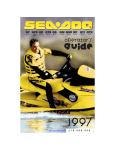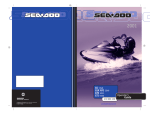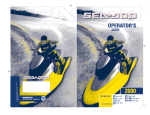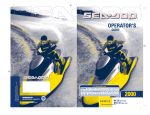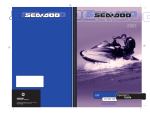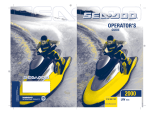Download Sea-doo GTX RFI 5843 Operating instructions
Transcript
www.SeaDooManuals.net smo9803a.fm5 Page -1 Thursday, January 29, 1998 8:38 AM SEA-DOO GTX RFI (5666/5843) OPERATOR’S GUIDE SUPPLEMENT This Operator’s Guide Supplement contains information specifically applicable to the GTX RFI (5666/5843) model. This supplement must be used in conjunction with the 1998 Sea-Doo Operator’s Guide (P/N 219 000 076), which contains all the general information. When a specific model is discussed, refer to the information regarding the GTX Limited, except for the following subjects covered in this supplement. ◆ SAFETY WARNING Disregarding any of the safety precautions and instructions contained in this Operator’s Guide Supplement, the Operator’s Guide, the Safety Handbook and on Product Warning Labels could cause injury, including the possibility of death. This Operator’s Guide Supplement, the Operator’s Guide, the Safety Handbook and Videocassette should remain with the watercraft at the time of resale. Litho’d in Canada (SMO-9803 FY) ®*Trademarks of Bombardier Inc. All rights reserved © Bombardier Inc. 1998 www.SeaDooManuals.net smo9803a.fm5 Page 0 Thursday, January 29, 1998 8:38 AM TABLE OF CONTENTS LOCATION OF THE IMPORTANT LABELS.................................... 1 WATERCRAFT IDENTIFICATION .................................................. COMPONENT FUNCTIONS ......................................................... 3 3 FUEL AND LUBRICATION ........................................................... 5 OPERATING INSTRUCTIONS ...................................................... POST-OPERATION CARE............................................................. 5 6 SPECIAL PROCEDURES.............................................................. 7 MAINTENANCE .......................................................................... 9 STORAGE ................................................................................... 11 10-HOUR INSPECTION CHECK LIST ........................................... 14 PERIODIC INSPECTION CHART .................................................. 15 PRE-SEASON PREPARATION CHART.......................................... 16 TROUBLESHOOTING................................................................... 17 SPECIFICATIONS ........................................................................ 20 www.SeaDooManuals.net smo9803a.fm5 Page 1 Thursday, January 29, 1998 8:38 AM LOCATION OF THE IMPORTANT LABELS Please read the following labels carefully before operating this watercraft. 1 10 6 5 2 3 7 F07L0TL 1 www.SeaDooManuals.net smo9803a.fm5 Page 2 Monday, January 26, 1998 3:55 PM 1 WARNING Read all warning label, Operator Guide & safety documents before operating. Severe injury or death can result from ignoring such information or improper use of the watercraft. Check throttle & steering operation before starting engine. Directional control is lost when throttle is released or engine shut off. Do not splash others or jump waves or wakes with this watercraft. Properly attach safety tether to your PFD. Keep a safe distance from other water users. Observe boating regulations. This watercraft is not design for night-time operation. F00A0RL 2 7 CAUTION TO AVOID POSSIBLE ENGINE FLOODING WHEN ROLLED OVER: • CAUTION MAKE SURE ENGINE IS OFF USE BOMBARDIER-ROTAX INJECTION OIL OR HIGHER QUALITY LOW ASH API TC INJECTION OIL FOR 2 CYCLES ENGINES. GRAB INLET GRATE AND STEP ON BUMPER RAIL ROLL BOAT COUNTERCLOCKWISE NEVER USE NMMA TC-W, TC-WII or TC-W3 outboard motor oils. F00L06Z F06L0DY "THIS BOAT IS NOT REQUIRED TO COMPLY WITH THE FOLLOWING U.S. COAST GUARD SAFETY STANDARDS IN EFFECT ON THE DATE OF CERTIFICATION: 3 Safe Loading Flotation Powered Ventilation Fuel System Display of Capacity Information AS AUTHORIZED BY U.S. COAST GUARD GRANT OF EXEMPTION (CGB 88-001)." Bombardier Corp. 7575 Bombardier Court, Wausau, WI 54401 Made in Canada/Fabriqué au Canada Bombardier Inc. Rd./Enr.,1988 F02L2DZ 10 WARNING ENGINE MUST BE OFF WHEN USING BOARDING STEP. KEEP AWAY FROM JET OR INTAKE GRATE. STAY ON CENTER OF THE STEP. ONLY ONE PERSON AT THE TIME ON THE STEP. NEVER USE THE STEP FOR PULLING, TOWING, DIVING OR JUMPING, BOARDING A PWC THAT IS OUT OF WATER OR ANY OTHER PURPOSE FOR WHICH IT WAS NOT DESIGNED. F07L11Y 5 WARNING WHILE FUELING, STOP ENGINE. FUEL TANK MAY BE PRESSURIZED, SLOWLY TURN CAP WHEN OPENING. KEEP WATERCRAFT LEVEL. DO NOT OVERFILL. CHECK OIL LEVEL. PERIODICALLY, VERIFY FUEL SYSTEM. F01L6VY 6 • WARNING DO NOT BOOST BATTERY WHILE INSTALLED. F00L05Y 2 www.SeaDooManuals.net smo9803a.fm5 Page 3 Monday, January 26, 1998 3:55 PM WATERCRAFT IDENTIFICATION To lock the storage compartment cover, insert key and rotate it 1/2 turn. Engine Identification Number The Engine Identification Number (E.I.N.) is located on the upper crankcase on PTO side. 1 F07L0VY 1. Insert key and rotate it 1/2 turn to lock cover To unlock the storage compartment cover, turn key in the opposite direction. F01D87Y 1 1. Engine Identification Number COMPONENT FUNCTIONS Added Features The following features have been added for this specific model. Adjustable Handlebar The handlebar height can be adjusted to suit rider preferences. To perform this adjustment, turn the knob underneath the handlebar. Storage Compartment Cover Safety Lock A convenient lock is provided to protect personal articles when the watercraft is unattended. 1 1 F07L0WY 1. Adjustment knob Cargo Cleats These cleats are provided for securing baggage. - F07L0UY 1. Safety lock CAUTION Do not use the cleats as a tiedown point for transportation or mooring. 3 www.SeaDooManuals.net smo9803a.fm5 Page 4 Monday, January 26, 1998 3:55 PM Bow Bag A convenient watertight bow bag is supplied with this watercraft. The bow bag is tailor-made for the front storage compartment. Modified or Deleted Features The following features have been either modified or deleted for this specific model. 1 F07L0XY 1. Cargo cleats (each side) Stern Eyelet This eyelet allows a rope with a hook, a closed end or an open end to be attached. Throttle Lever When the engine is stopped, no fuel is injected when depressing the throttle lever. The carburetors are replaced by a throttle body. Any reference to the carburetors in the Operator’s Guide should be disregarded. Choke Lever There is no choke lever. The enrichment of the air/fuel mixture is controlled by the electronic control unit (ECU). Any reference to the choke cable in the Operator’s Guide should be disregarded. 1 F07L0YY 1. Stern eyelet Boarding Step A convenient step to help reboarding the watercraft. ◆ WARNING Engine must be OFF when using boarding step. Keep away from jet or intake grate. Stay on center of the step. Only one person at the time on the step. Never use the step for pulling, towing, diving or jumping, boarding a PWC that is out of water or any other purpose for which it was not designed. Fuel Valve With the Rotax Fuel Injection, there is no need for a fuel valve. There is no reserve. When the fuel is low in the tank (1/8), the Info Center displays a “LOW FUEL” warning message and the LED will blink. Every 55 seconds, the monitoring beeper will also sound 5 seconds to warn the operator. ◆ WARNING Always refill the fuel tank at the first opportunity. Any reference to the fuel valve in the Operator’s Guide should be disregarded. 4 www.SeaDooManuals.net smo9803a.fm5 Page 5 Monday, January 26, 1998 3:55 PM FUEL AND LUBRICATION Recommended Fuel Use unleaded gasoline with a minimum of 87 octane (RON + MON/2) specification. NOTE: Look on service station pump sticker for octane specification. Do not mix oil with fuel except at engine break-in. Always check injection oil tank level when refueling. The use of good quality fuel is necessary. A well known fuel brand is highly recommended. - CAUTION Never experiment with other fuels or fuel ratios. Never use fuel containing more than 10% alcohol (ethanol or methanol). The use of non-recommended fuel can result in watercraft performance deterioration and damage to critical parts in the fuel system and engine components. Recommended Oil Use BOMBARDIER ROTAX INJECTION OIL which is available from authorized dealers. It is a blend of specially selected base oils and additives which provides proper lubrication, engine cleanliness and minimum spark plug fouling. NOTE: High quality low ash API TC injection oil for 2-cycle engines can be used if BOMBARDIER ROTAX INJECTION OIL is not available. - CAUTION Never use 4-cycle petroleum or synthetic motor oil and never mix these with outboard motor oil. Do not use NMMA TC-W, TC-W2 or TC-W3 outboard motor oils or other ashless type 2-cycle oil. Avoid mixing different brands of API TC oil as resulting chemical reaction may cause severe engine damage. OPERATING INSTRUCTIONS Starting the Engine Before unloading the watercraft from the trailer, it can be started for about 10 seconds to verify proper operation. ◆ WARNING Do not touch electrical parts or jet pump area when engine is running. Attach the safety lanyard to the operator’s PFD and snap the cap to the switch before starting the engine. ◆ WARNING Only start the watercraft once all controls have been checked and operate properly. Operator and passenger (if applicable) should be sitting on the watercraft seat prior to starting the engine. Cold and Warm Engine Firmly grip handlebar with both hands and place both feet on the floorboard. To start engine, depress and hold the button. Release immediately after engine is started. 5 www.SeaDooManuals.net smo9803a.fm5 Page 6 Friday, February 20, 1998 3:40 PM NOTE: Do not depress the throttle lever to start either a cold or warm engine. Slowly accelerate to reach deeper water. Do not apply full throttle until the engine is at normal operating temperature. ◆ To flush engine, connect a garden hose to the water outlet located at the rear of watercraft near the jet pump. NOTE: A quick connect adapter is supplied with the watercraft and can be used to ease hose installation. WARNING In shallow water, shells, sand, pebbles or other objects could be drawn up by the jet pump and damage impeller, components or clog the cooling system. Also, debris could be thrown rearward into bystanders. POST-OPERATION CARE Cooling System Flushing and Engine Internal Lubrication Flushing the cooling system with fresh water is essential to neutralize corroding effects of salt or other chemical products present in water. It will help to clean up sand, salt, shells or other particles in water jackets (engine, exhaust manifold, tuned pipe) and/or hoses. Engine lubrication and flushing should be performed when the watercraft is not expected to be used further the same day or when the watercraft is stored for any extended time. Proceed as follows: ◆ WARNING Perform this operation in a well ventilated area. Clean jet pump by spraying water in its inlet and outlet and then BOMBARDIER LUBE lubricant. 6 3 F07E01Y 2 1 TYPICAL 1. Water outlet 2. Quick connect adapter (supplied) 3. Garden hose Start the engine then immediately open the water tap. ◆ WARNING Do not touch any electrical parts or jet pump area when engine is running. - CAUTION Never flush a hot engine. Always start the engine before opening the water tap. Open water tap immediately after engine is started to prevent overheating. Run the engine about 3 minutes at a fast idle around 3500 RPM. www.SeaDooManuals.net smo9803a.fm5 Page 7 Friday, February 20, 1998 3:41 PM Spray BOMBARDIER LUBE lubricant into air intake silencer keeping engine at fast idle. 2 1 3 F07H0AY 1 1. Grounding device F01F25Y 1. Air intake silencer 2. Pull plug 3. Spray BOMBARDIER LUBE here NOTE: Lubrication of engine should be done for at least 1 minute. Close the water tap then stop the engine. - CAUTION Always close the water tap before stopping the engine. Disconnect the garden hose. Wipe up any residual water from the engine. Remove spark plug cables and connect them on the grounding device. ◆ WARNING Always use spark plug cable grounding device when removing spark plugs. Remove both spark plugs and spray BOMBARDIER LUBE lubricant into each cylinder. NOTE: For the storage period, use Bombardier storage oil (P/N 413 711 600). Fully apply the throttle lever then depress the start/stop button to crank the engine a few turns to distribute the oil onto cylinder wall. NOTE: No fuel is injected in the engine when the throttle lever is fully applied then the starter activated. Apply anti-seize lubricant on spark plug threads then reinstall them. Reinstall plug on air intake silencer cover. NOTE: Engine fogging should be done whenever the watercraft is to be stored for a few days or a long period. SPECIAL PROCEDURES Submerged Watercraft If the watercraft is submerged and engine is water-flooded, it is strongly recommended that the watercraft be serviced by an authorized dealer immediately. In the event the engine cannot be serviced within a few hours, remove spark plug cables and connect them on the grounding device. www.SeaDooManuals.net 7 smo9803a.fm5 Page 8 Monday, January 26, 1998 3:55 PM ◆ WARNING Never crank engine with spark plugs removed unless spark plug cables are connected to the grounding device. Remove spark plugs and dry them with a clean and dry cloth. Cover spark plug holes with a rag. Fully apply the throttle lever then depress the start/stop button to crank engine for approximately 10 seconds. This will allow water to escape from spark plug openings. Spray BOMBARDIER LUBE lubricant into spark plug holes. Crank engine again with the throttle fully applied. Reinstall spark plugs. Towing the Watercraft in Water Special precautions should be taken when towing a Sea-Doo watercraft in water. Maximum recommended towing speed is 24 km/h (15 MPH). When towing your watercraft in water, pinch the water supply hose from the impeller housing to the engine with a large hose pincher (P/N 529 030 400) shown in the following illustration. This will prevent the cooling system from filling which may lead to water being injected into and filling the exhaust system. Without the engine running there isn’t any exhaust pressure to carry the water out of the exhaust outlet. - CAUTION Failure to do this may result in damage to the engine. If you must tow a stranded watercraft in water and do not have a hose pincher be sure to stay well below the maximum towing speed of 24 km/h (15 MPH). Snugly install the hose pincher on the hose as shown. 1 F07E04Y 1. Hose pincher - CAUTION When finished towing the watercraft, hose pincher must be removed before operating it. F01B23Y 8 www.SeaDooManuals.net smo9803a.fm5 Page 9 Friday, February 20, 1998 3:41 PM Flooded Engine If the engine does not start and it is suspected to be flooded, proceed as follows: Remove spark plug cables and connect them on the grounding device. ◆ 2 WARNING Always use spark plug cable grounding device when removing spark plugs. Remove spark plugs and dry them using a rag. Cover spark plug holes with a rag. Install the safety lanyard cap on the switch. Depress and hold the throttle lever at full throttle position. Depress the start/stop button to crank the engine approximately 10 seconds. Proceeding in this order, no fuel is injected and the accumulated fuel in the engine will be expelled. Reinstall spark plugs and connect cables. Start engine normally without applying the throttle. 1 F01I0AY 1. Flywheel guard 2. Wing nuts Using a grease gun, carefully lubricate PTO flywheel at grease fitting until boot is just beginning to expand. - CAUTION Immediately stop lubricating as soon as boot begins to expand. MAINTENANCE Lubrication Use SEA-DOO synthetic grease and lubricate the PTO flywheel every 10 hours. Proceed as follows: Remove seats to expose engine compartment. Remove the wing nuts, washers and pull out PTO flywheel guard. ◆ F01I0BY 1 1. Grease PTO flywheel Secure PTO flywheel guard. WARNING Always remove safety lanyard cap from its receptacle to prevent accidental engine starting before r e mo vi n g th e PT O f l yw he e l guard. www.SeaDooManuals.net 9 smo9803a.fm5 Page 10 Monday, January 26, 1998 3:55 PM Fuses The electrical system is protected with 5 fuses. Three fuses are located on the MultiPurpose Electronic Module (MPEM) and the other two fuses are in the rear electrical box. Two fuses protect the charging system. If the battery is regularly discharged, check the 15 A fuse on the MPEM and the 20 A fuse in the rear electrical box. A 5 A fuse protects the power supply of the MPEM. If the starter does not operate, check the 5 A fuse. The second 20 A fuse in the rear electrical box protects the power supply of the Electronic Control Unit (ECU). The 7.5 A fuse on the MPEM protects the fuel pump. If the engine does not start, check this fuse. To access fuses on the Multi-Purpose Electronic Module, open storage compartment cover and remove basket. Locate MPEM on the left side of watercraft. Unclip the fuse cover from the MPEM. 1 F06H1TY NOTE: There is 2 spare fuses on the MPEM. To access the 20 A fuses in the rear electrical box, remove seats. Remove basket. Unclip and remove cover of the rear electrical box. 1 F07H08Y 1 1. Rear electrical box 1 F06H1SY 2 TYPICAL 1. MPEM 2. Fuse cover Use the tabs of the fuse cover to remove and reinstall fuses. 2 1. Fuse cover 2. Fuse tabs F07H09Y REAR ELECTRICAL BOX OPENED 1. Fuse holders 10 www.SeaDooManuals.net smo9803a.fm5 Page 11 Monday, January 26, 1998 3:55 PM Unclip and pull out fuse holders to check fuse condition. If a fuse is defective, replace it by one of the same rating. - CAUTION Do not use a higher rated fuse as this can cause severe damage. Refer to SPECIFICATIONS section for recommended fuse rating. If a fuse is regularly burnt, refer to an authorized dealer. ◆ WARNING If any water is found in the rear electrical box, immediately refer to an authorized dealer before operating the watercraft. 1 F07E05Y 1. Disconnect this hose Water should flow out of the fitting (magneto cooling circuit) and hose (crankcase heat exchanger). NOTE: Ensure to properly close cover of the rear electrical box, making sure seal is well positioned. STORAGE It is recommended that the watercraft be serviced by an authorized dealer for storage but the following operations can be performed by you with a minimum of tools. - F07E06Y Engine Draining Disconnect the water supply hose used to cool the magneto. It features a quick connect fitting. Press both tabs and pull fitting in order to disconnect hose. This hose is located at the bottom of the magneto cover beside the engine support. 1 1. Make sure water flows out of fitting and hose - CAUTION Do not run the engine during the storage period. 1 CAUTION Water in engine must be free to flow out. Should water freeze in engine, severe damage will occur. Fuel System SEA-DOO fuel stabilizer (or equivalent), can be added in fuel tank to prevent fuel deterioration. Follow manufacturer’s instructions for proper use. NOTE: Fuel stabilizer should be added prior engine lubrication. 11 www.SeaDooManuals.net smo9803a.fm5 Page 12 Monday, January 26, 1998 3:55 PM Cooling System Flushing and Engine Internal Lubrication Refer to procedure in POST-OPERATION CARE. Propulsion System Lubricant in jet pump reservoir should be drained and reservoir cleaned. Refill with SEA-DOO synthetic polyolester oil (75W90 GL5 type C gear lube). Refer to an authorized dealer for this operation. - CAUTION Use only SEA-DOO jet pump oil or equivalent synthetic gear oil, otherwise component service life could be reduced. Do not mix oil brands or types. Grease PTO flywheel as explained in the MAINTENANCE section. Battery Contact your authorized dealer or refer to the appropriate Shop Manual for proper storage procedure. Watercraft Cleaning Clean the bilge with hot water and detergent or with bilge cleaner. Rinse thoroughly. Lift front end of watercraft to completely drain bilge. If any repairs are needed to body or to the hull contact your dealer. For paint touch up to mechanical parts use Bombardier spray paint. For small gelcoat repairs, a Bombardier repair kit is available. Replace damaged labels/decals. NOTE: Bilge cleaning should be done prior to anticorrosion treatment. Wash the body with soap and water solution (only use mild detergent). Rinse thoroughly with fresh water. Remove marine organisms from the hull. Apply a good quality marine wax. - CAUTION Never clean apparent fiberglass and plastic parts with strong detergent, degreasing agent, paint thinner, acetone, etc. If the watercraft is to be stored outside, cover it with an opaque tarpaulin to prevent sun rays and grime from affecting the plastic components, watercraft finish as well as preventing dust accumulation. - CAUTION The watercraft must never be left in water for storage. Never leave the watercraft stored in direct sunlight. Anticorrosion Treatment Wipe off any residual water in the engine compartment. Spray BOMBARDIER LUBE lubricant over metallic components in engine compartment. Lubricate the throttle cable with BOMBARDIER LUBE lubricant. The front seat should be partially left opened during storage. This will avoid engine compartment condensation and possible corrosion. Additional Recommended Protection In cool regions (where freezing point may be encountered), cooling system should be filled with an equal part of water and antifreeze solution. - CAUTION During winter storage in cold climates (where freezing may occur), always add antifreeze and water solution to cooling system. Mix in equal parts. 12 www.SeaDooManuals.net smo9803a.fm5 Page 13 Monday, January 26, 1998 3:55 PM - CAUTION Always use ethylene glycol antifreeze containing corrosion inhibitors specifically recommended for aluminum engines. Install a hose pincher to water return hose of the magneto cooling circuit. F06E0FY 1 TYPICAL 1. Hose pincher installed on the engine water supply hose F07E07Y 1 1. Hose pincher to water return hose Disconnect the engine water return hose. F06E0EY 1 TYPICAL 1. Disconnect the engine water return hose Install a hose pincher to engine water supply hose. Temporarily install a short piece of hose to engine water return at cylinder head. Insert a funnel into hose and pour antifreeze mixed with water in engine until the colored solution appears in the water return hose of the magneto cooling circuit. Remove temporary hose and reconnect engine water return hose. Remove hose pinchers. Most of the antifreeze will drain out from fitting near the exhaust outlet when removing the hose pinchers. Use a container to recover it. DISPOSE OF ANTIFREEZE AS PER YOUR LOCAL LAWS AND REGULATIONS. NOTE: Although antifreeze will mainly drain out, the antifreeze has mixed with the water that was possibly trapped in the cylinder water jackets, crankcase heat exchanger and the magneto cooling circuit, preventing freezing problems. At pre-season preparation, drain the remaining antifreeze from cooling system prior using the watercraft. 13 www.SeaDooManuals.net smo9803a.fm5 Page 14 Monday, January 26, 1998 3:55 PM 10-HOUR INSPECTION CHECK LIST ✓ DESCRIPTION Engine ignition timing if required Spark plug inspection, cleaning and adjustment Fuel system lines and fasteners/pressurization test Throttle cable adjustment if required Oil lines and filter Oil injection pump adjustment if required Engine support and engine rubber mounts Muffler, battery and reservoir fastening devices Exhaust system hose clamps Throttle body and flame arrester base Steering system inspection Steering cable adjustment if required Reverse cable adjustment if required Cooling system hose condition and fasteners Bailer pick-ups, check for obstructions Fuel injection sensors verification Digitally Encoded Security System Monitoring beeper Ground connections (starter, battery, etc.) Jet pump oil replacement PTO flywheel lubrication Seal carrier verification Inspection of fasteners for tightness Hull inspection We recommend that this inspection chart be signed by an authorized dealer. Date of 10-hour inspection Authorized dealer signature Dealer code The 10-hour inspection is at the expense of the watercraft owner. 14 www.SeaDooManuals.net smo9803a.fm5 Page 15 Thursday, January 29, 1998 8:37 AM PERIODIC INSPECTION CHART ➀ Lubrication/corrosion protection every 100 hours or seasonally every 50 hours DESCRIPTION every 25 hours every 10 hours FREQUENCY ✔ OPERATOR ✔ Engine ignition timing ✔ Spark plug replacement DEALER ✔ Fuel injection sensors verification ➀ Throttle cable, inspection/lubrication ✔ ✔ Oil injection pump adjustment ✔ ✔ ✔ ✔ Oil tank straps ✔ DEALER DEALER DEALER Oil filter replacement Fuel tank straps DEALER OPERATOR Throttle cable adjustment Oil filter inspection DEALER DEALER ✔ Fuel injector cleaning To be performed by DEALER OPERATOR OPERATOR Engine head bolts, retorque ✔ DEALER Engine counterbalance shaft oil level ✔ DEALER ✔ DEALER ✔ Steering system Reverse system/reverse cable adjustment Fastener tightening (flame arrester, throttle body, engine mount, exhaust system, etc.) ✔ ✔ ✔ ✔ OPERATOR ✔ ✔ Fuel vent line pressure relief valve inspection DEALER ✔ DEALER ✔ Monitoring beeper ✔ Jet pump reservoir oil level/oil condition Jet pump cover pusher inspection Impeller condition and impeller/wear ring clearance ✔➁ Drive shaft boot and spline condition ✔➁ DEALER Replace DEALER ✔ DEALER DEALER DEALER ✔ OPERATOR Seal carrier inspection Water intake grate condition ✔ DEALER ✔➁ OPERATOR ✔ Hull condition ✔➂ Cooling system flushing DEALER DEALER ✔ Battery condition Ground connections (battery, starter, etc.) PTO flywheel lubrication DEALER ✔ Muffler, battery and reservoir fastening devices Fuel lines, check-valve and fuel system pressurization DEALER OPERATOR OPERATOR ➀ Every 10 hours in salt water use. ➁ These items have to be initially checked after 25 hours. Thereafter, servicing to be made as specified in this chart. ➂ Daily flushing in salt water or foul water use. 15 www.SeaDooManuals.net smo9803a.fm5 Page 16 Thursday, January 29, 1998 8:37 AM PRE-SEASON PREPARATION CHART NOTE: It is highly recommended that the dealer perform the annual safety inspection and factory campaigns in addition to the pre-season preparation all at the same time. OPERATIONS Lubrication/corrosion protection To be performed by OPERATOR Battery condition/charging and reinstallation Battery, starter connections and routing ➁ Spark plug replacement ➀ DEALER DEALER OPERATOR Jet pump oil inspection DEALER Propulsion system inspection DEALER Oil filter replacement DEALER Fuel tank straps OPERATOR Oil tank straps OPERATOR Oil injection tank filling OPERATOR Flame arrester inspection ➁ DEALER Fuel line condition ➁ DEALER Filler neck, fuel tank and fuel cap condition ➁ DEALER Check valves, fasteners, fuel system pressurization ➁ DEALER Throttle ➁ cable inspection/adjustment DEALER Oil injection pump adjustment and bleeding DEALER Engine ignition timing DEALER Fuel injection sensors verification DEALER Steering system adjustment/inspection ➁ DEALER Reverse cable adjustment DEALER Inspection of bailer pick-ups DEALER Inspection of cooling system hoses DEALER Monitoring beeper DEALER Digitally encoded security system DEALER ➀ Before installing new spark plugs, it is suggested to burn the excess BOMBARDIER LUBE lubricant by starting the engine using the old spark plugs. ➁ Safety item covered in the annual safety inspection. 16 www.SeaDooManuals.net smo9803a.fm5 Page 17 Thursday, January 29, 1998 8:37 AM TROUBLESHOOTING The following chart is provided to help in diagnosing the probable source of simple troubles. You may be able to solve many of these problems rather quickly, but others may require the skills of a mechanical technician. In such cases, consult an authorized dealer for servicing. Monitoring Beeper Coded Signals CODED SIGNALS 2 short beeps (while installing safety lanyard on switch). 1 long beep (while installing safety lanyard on craft switch or when pressing start/stop button). POSSIBLE CAUSE • Confirms safety lanyard signal operation. REMEDY Engine can be started. • Safety lanyard on switch for more than 10 minutes without starting engine. • Bad connection. Remove and reinstall safety lanyard on switch. • Wrong safety lanyard. • Defective safety lanyard. 4 short beeps A 2 seconds beep every 60 seconds intervals. 8 short beeps. Continuously beeps. • Salt water in safety lanyard cap. • Improper operation of MPEM or defective wiring harness. • Discharged battery. Reinstall safety lanyard cap correctly over switch. Use a safety lanyard that has been programmed for the craft. Use another programmed safety lanyard. Clean safety lanyard cap to remove salt water. Refer to an authorized dealer. Refer to an authorized dealer. • No communication between ECU and MPEM. • Fuel tank level is low. Refill. • Defective MPEM. • Engine overheats. Refer to an authorized dealer. See ENGINE OVERHEATING. POSSIBLE CAUSE • Safety lanyard removed. • Burnt fuse. • Discharged battery. • Battery connections, corroded or loose. • Water flooded engine. REMEDY Install cap over switch. Check wiring then replace fuse. Refer to an authorized dealer. Refer to an authorized dealer. Refer to an authorized dealer. Engine will not Start OTHER OBSERVATION Engine does not turn over. Engine turns slowly. Engine turns normally. • Discharged or weak battery. • Fuel flooded engine. • Fuel tank empty or watercontaminated. • Burnt fuel pump fuse • Fouled/defective spark plugs. • Electrical problem. Refer to Submerged Watercraft in SPECIAL PROCEDURES. Refer to an authorized dealer. Refer to Flooded Engine in SPECIAL PROCEDURES. Refill. Siphon and fill with fresh fuel. Check wiring then replace fuse. Replace. Refer to an authorized dealer. 17 www.SeaDooManuals.net smo9803a.fm5 Page 18 Friday, February 20, 1998 3:43 PM Engine Misfires, Runs Irregularly OTHER OBSERVATION Weak spark. Lean fuel mixture. Rich fuel mixture (high fuel consumption). POSSIBLE CAUSE • Fouled/defective/worn spark plugs. • Faulty rev limiter. • Fuel: Level too low, stale or water-contaminated. • Clogged fuel injectors. • Defective sensor or ECU. • Flame arrester dirty/clogged. • Defective sensor or ECU. REMEDY Replace. POSSIBLE CAUSE • Clogged jet pump water intake. • Clogged coolant system. REMEDY Clean. Refer to an authorized dealer. Siphon and/or refill. Refer to an authorized dealer. Refer to an authorized dealer. Clean or replace. Refer to an authorized dealer. Engine Overheats OTHER OBSERVATION Monitoring beeper sounds continuously. Flush cooling system. Engine Continually Backfires OTHER OBSERVATION Weak spark. Overheated engine. POSSIBLE CAUSE • Fouled/defective/worn spark plugs. • See ENGINE OVERHEATS. REMEDY Replace. Refer to an authorized dealer. Engine Pinging or Knocking OTHER OBSERVATION POSSIBLE CAUSE • Poor quality gasoline/low octane. • Spark plug heat range too high. • Ignition timing. REMEDY Use well known quality and recommended gasoline. Use recommended spark plugs. Refer to an authorized dealer. Engine Lacks Acceleration or Power OTHER OBSERVATION Overheated engine. 18 POSSIBLE CAUSE • Clogged fuel injectors. • Low fuel pressure. • Stick RAVE valves. • See ENGINE OVERHEATS. REMEDY Refer to an authorized dealer. Refer to an authorized dealer. Refer to an authorized dealer. www.SeaDooManuals.net smo9803a.fm5 Page 19 Monday, January 26, 1998 3:55 PM Watercraft Can Not Reach Top Speed OTHER OBSERVATION Cavitation. POSSIBLE CAUSE • Jet pump water intake clogged. • Damaged impeller. REMEDY Clean. Replace. Refer to an authorized dealer. Abnormal Noise from Propulsion System OTHER OBSERVATION Cavitation. POSSIBLE CAUSE • Weeds or debris jammed around impeller. • Damaged impeller shaft or drive shaft. REMEDY Clean and check for damage. Refer to an authorized dealer. 19 www.SeaDooManuals.net smo9803a.fm5 Page 20 Monday, February 2, 1998 9:43 AM SPECIFICATIONS ENGINE Engine type Induction type Exhaust system Exhaust valve Lubrication GTX RFI (5666/5843) Bombardier-Rotax 787, 2-stroke Rotary valve Water cooled/water injected with regulator Rotax Adjustable Variable Exhaust (R.A.V.E.) Oil injection BOMBARDIER-ROTAX injection oil 2 781.6 cm3 (47.7 in3) 7100 (± 50) RPM Type Oil type Number of cylinders Displacement Rev limiter setting COOLING SYSTEM Type Water cooled, total loss type. Direct flow from propulsion unit. ELECTRICAL SYSTEM Magneto generator output Ignition system type Spark plug Make and type Gap Starting system Battery Fuse FUEL SYSTEM Fuel type Fuel injection 270 W @ 6000 RPM Digital inductive type NGK, BR8ES 1.0 mm (.039 in) Electric starter 12 V, 19 A Starting system Charging system Fuel pump MPEM 5A 15 A (1) 20 A (1) 7.5 A 5A Regular unleaded gasoline Rotax Fuel Injection, single throttle body 20 www.SeaDooManuals.net smo9803a.fm5 Page 21 Friday, February 20, 1998 3:43 PM PROPULSION Propulsion system Jet pump type Transmission Impeller shaft reservoir oil type Pivoting angle of direction (nozzle) Minimum required water level for jet pump GTX RFI (5666/5843) Bombardier Formula pump Axial flow, single stage Direct drive SEA-DOO jet pump synthetic polyolester oil 75W90 GL5 ~ 23° DIMENSIONS Number of passengers ➀ Overall length 3 312 cm (122.8 in) Overall width Overall height Weight Load limit (passengers + luggage) CAPACITIES Fuel tank Impeller shaft reservoir 90 cm (3 ft) 119 cm (47 in) 94 cm (37 in) 288 kg (635 lb) 242 kg (534 lb) 56.5 L (15 U.S. gal) 125 mL (4.2 U.S. oz) Up to plug 6 L (1.6 U.S. gal) Capacity Oil level Oil injection reservoir ➀ Refer to load limit. N.A.: Not Applicable. BOMBARDIER INC. reserves the right to make changes in design and specifications and/or to make additions to, or improvements in its products without imposing any obligation upon itself to install them on its products previously manufactured. www.SeaDooManuals.net 21 smo9803a.fm5 Page 22 Tuesday, January 27, 1998 11:38 AM NOTES www.SeaDooManuals.net www.SeaDooManuals.net




























